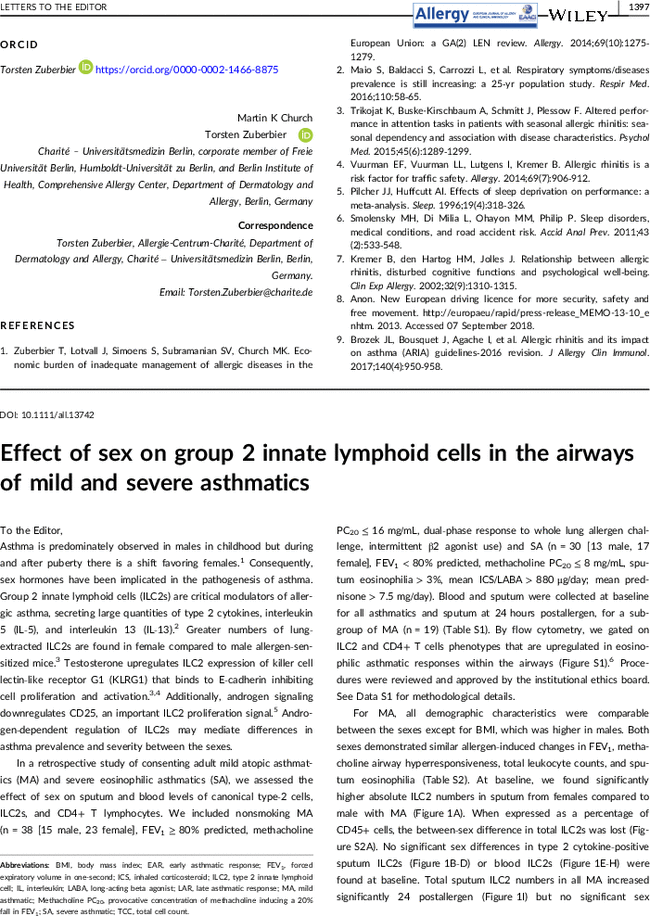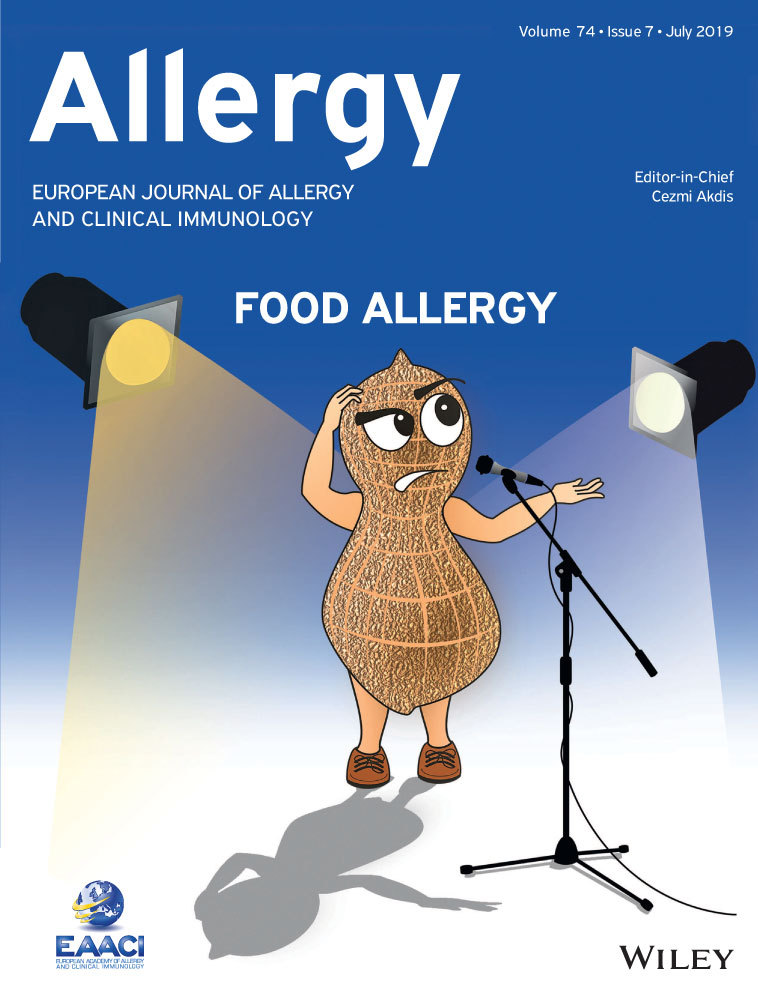Effect of sex on group 2 innate lymphoid cells in the airways of mild and severe asthmatics
Michael Aw
Cardiorespiratory Research, Department of Medicine, McMaster University, Hamilton, Ontario, Canada
Search for more papers by this authorParameswaran Nair
Firestone Institute for Respiratory Health, St. Joseph's Healthcare, Hamilton, Ontario, Canada
Search for more papers by this authorBrittany Salter
Cardiorespiratory Research, Department of Medicine, McMaster University, Hamilton, Ontario, Canada
Search for more papers by this authorRuchong Chen
Cardiorespiratory Research, Department of Medicine, McMaster University, Hamilton, Ontario, Canada
State Key Laboratory of Respiratory Disease, The First Affiliated Hospital of Guangzhou Medical University, Guangzhou, Guangdong, China
Search for more papers by this authorKentaro Machida
Cardiorespiratory Research, Department of Medicine, McMaster University, Hamilton, Ontario, Canada
Department of Pulmonary Medicine, Graduate School of Medical & Dental Sciences, Kagoshima University, Kagoshima, Japan
Search for more papers by this authorMark Inman
Firestone Institute for Respiratory Health, St. Joseph's Healthcare, Hamilton, Ontario, Canada
Search for more papers by this authorPaul M. O'Byrne
Cardiorespiratory Research, Department of Medicine, McMaster University, Hamilton, Ontario, Canada
Search for more papers by this authorGail M. Gauvreau
Cardiorespiratory Research, Department of Medicine, McMaster University, Hamilton, Ontario, Canada
Search for more papers by this authorCorresponding Author
Roma Sehmi
Cardiorespiratory Research, Department of Medicine, McMaster University, Hamilton, Ontario, Canada
Correspondence
Roma Sehmi, Cardiorespiratory Research Group, Department of Medicine, McMaster University, Hamilton, ON, Canada.
Email: [email protected]
Search for more papers by this authorMichael Aw
Cardiorespiratory Research, Department of Medicine, McMaster University, Hamilton, Ontario, Canada
Search for more papers by this authorParameswaran Nair
Firestone Institute for Respiratory Health, St. Joseph's Healthcare, Hamilton, Ontario, Canada
Search for more papers by this authorBrittany Salter
Cardiorespiratory Research, Department of Medicine, McMaster University, Hamilton, Ontario, Canada
Search for more papers by this authorRuchong Chen
Cardiorespiratory Research, Department of Medicine, McMaster University, Hamilton, Ontario, Canada
State Key Laboratory of Respiratory Disease, The First Affiliated Hospital of Guangzhou Medical University, Guangzhou, Guangdong, China
Search for more papers by this authorKentaro Machida
Cardiorespiratory Research, Department of Medicine, McMaster University, Hamilton, Ontario, Canada
Department of Pulmonary Medicine, Graduate School of Medical & Dental Sciences, Kagoshima University, Kagoshima, Japan
Search for more papers by this authorMark Inman
Firestone Institute for Respiratory Health, St. Joseph's Healthcare, Hamilton, Ontario, Canada
Search for more papers by this authorPaul M. O'Byrne
Cardiorespiratory Research, Department of Medicine, McMaster University, Hamilton, Ontario, Canada
Search for more papers by this authorGail M. Gauvreau
Cardiorespiratory Research, Department of Medicine, McMaster University, Hamilton, Ontario, Canada
Search for more papers by this authorCorresponding Author
Roma Sehmi
Cardiorespiratory Research, Department of Medicine, McMaster University, Hamilton, Ontario, Canada
Correspondence
Roma Sehmi, Cardiorespiratory Research Group, Department of Medicine, McMaster University, Hamilton, ON, Canada.
Email: [email protected]
Search for more papers by this authorFunding information
M Aw was funded by summer scholarships from AllerGen NCE and the McMaster Bachelor of Health Sciences Program. Dr Nair is supported by the Frederick E. Hargreave Teva Innovation chair in Airway Diseases. Dr. Sehmi is funded by grants from the Canadian Lung Association and AllerGen NCE. These agencies did not have any role in the design or conduct of this retrospective study, interpretation of data or preparation of this manuscript.

Supporting Information
| Filename | Description |
|---|---|
| all13742-sup-0001-Supinfo.docxWord document, 1.6 MB |
Please note: The publisher is not responsible for the content or functionality of any supporting information supplied by the authors. Any queries (other than missing content) should be directed to the corresponding author for the article.
REFERENCES
- 1Carey MA, Card JW, Voltz JW, et al. It's all about sex: gender, lung development and lung disease. Trends Endocrinol Metab. 2007; 18: 308-313.
- 2Wolterink R, Kleinjan A, van Nimwegen M, et al. Pulmonary innate lymphoid cells are major producers of IL-5 and IL-13 in murine models of allergic asthma. Eur J Immunol. 2012; 42: 1106-1116.
- 3Laffont S, Blanquart E, Savignac M, et al. Androgen signaling negatively controls group 2 innate lymphoid cells. J Exp Med. 2017; 214: 1581-1592.
- 4Kadel S, Ainsua-Enrich E, Haripoglu I, et al. A major population of functional KLRG1– ILC2s in female lungs contributes to a sex bias in ILC2 numbers. Immunohorizons. 2018; 2: 74-86.
- 5Cephus JY, Stier MT, Fuseini H, et al. Testosterone attenuates group 2 innate lymphoid cell-mediated airway inflammation. Cell Rep. 2017; 21: 2487-2499.
- 6Chen R, Smith SG, Salter B, et al. Allergen-induced increases in sputum levels of group 2 innate lymphoid cells in subjects with asthma. Am J Respir Crit Care Med. 2017; 196: 700-712.
- 7Smith SG, Chen R, Kjarsgaard M, et al. Increased numbers of activated group 2 innate lymphoid cells in the airways of patients with severe asthma and persistent airway eosinophilia. J Allergy Clin Immunol. 2016; 137: 75-86.
- 8Morrison D, Capewell S, Reynolds P, et al. Testosterone levels during systemic and inhaled corticosteroid therapy. Respir Med. 1994; 88(9): 659-663.
- 9Brestoff JR, Kim BS, Saenz SA, et al. Group 2 innate lymphoid cells promote beiging of white adipose tissue and limit obesity. Nature. 2014; 519: 242.




